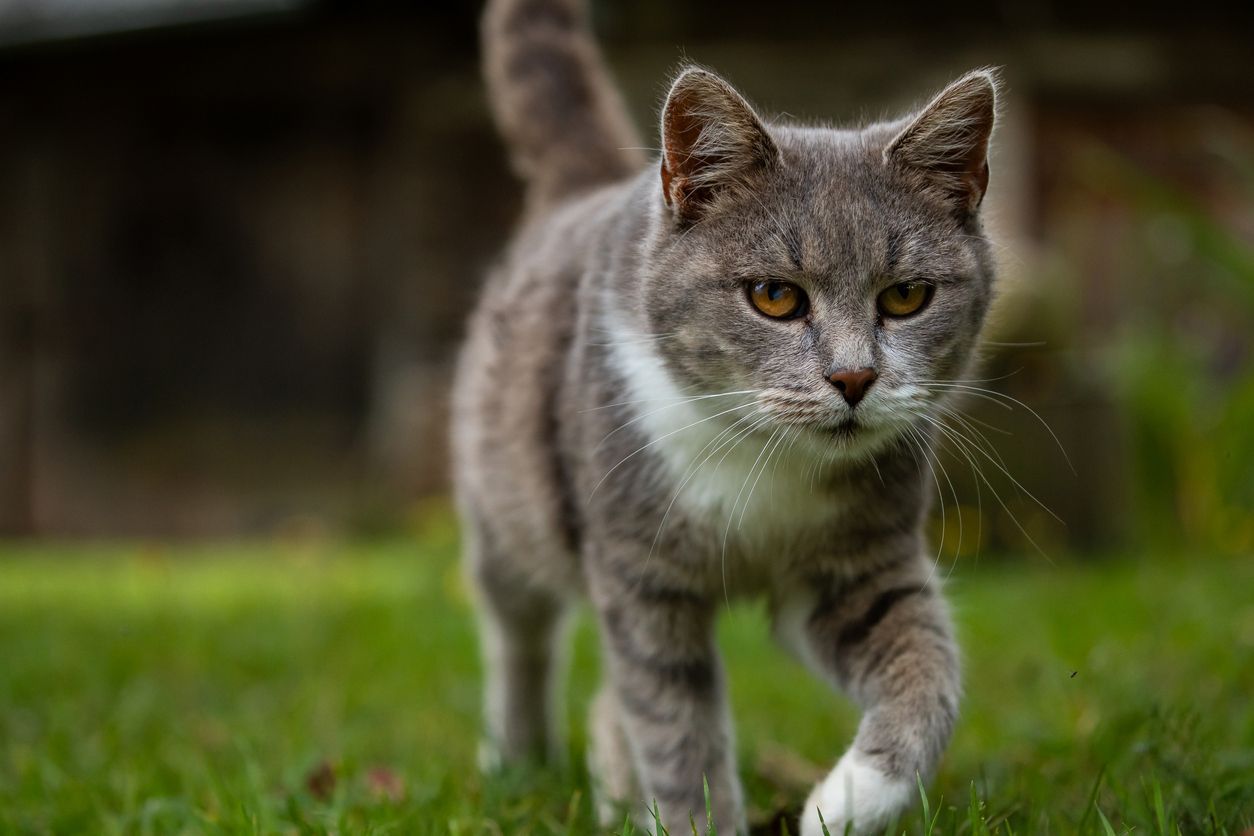What to do if your cat is limping

Disclaimer: This article, its content, and its related references do not constitute veterinary advice and should not be considered a substitute for veterinary care. If your pet is showing any symptoms that could indicate a medical emergency, please seek immediate emergency care.
Limping in cats is caused by injury, infection, or other diseases. If you notice your cat is limping, it’s important to observe them closely so you can describe their symptoms to a veterinarian. Read on to learn:
- What limping can look like in cats
- What to do if your cat is limping
- Common reasons why cats begin limping
- How the cause of limping is diagnosed and treated in cats
The severity of a cat’s limp can vary dramatically, and the symptoms may appear to improve or get worse throughout the day. A video taken at home can help by allowing a vet to observe the behavior outside of the hospital. Prompt veterinary attention is recommended for limping cats to get a proper diagnosis and create an effective treatment plan. Depending on the underlying cause, limping may be accompanied by other symptoms that indicate a need for emergency care, such as pale gums, labored breathing, collapse, seizures, or obvious severe injury, such as major bleeding or broken bones poking through the skin. Other signs of illness that may accompany limping include lack of appetite, vomiting, or diarrhea. Even without additional symptoms, it’s a good idea to get prompt veterinary care for your limping cat.
What does limping in cats look like?
Limping is when a cat doesn’t want to put their full weight on a leg or paw, disrupting the way they normally walk. Limping, or lameness, can appear differently based on the underlying cause. Some characteristics include whether the limp:
- Affects one or multiple legs
- Gets worse after rest or exercise
- Starts suddenly or develops gradually
- Is accompanied by other symptoms
- Shifts between limbs
- Is partially or completely non-weight-bearing
Depending on why a cat is limping, they may seem otherwise fine or they may show other signs of illness. Sometimes, a cat’s lameness comes and goes, usually in relation to their activity level. Noticing what the limping looks like, when it gets better or worse, and identifying any other signs of injury or illness can be helpful to a veterinarian in making an accurate diagnosis.
Other symptoms associated with lameness in cats
A limping cat may or may not show other physical or behavioral symptoms. If they do, physical symptoms associated with limping in cats can include:
- Visible swelling or redness on an affected paw or leg
- Joint or bone set in an odd position
- Bite, scratch, cut, puncture wound, or other obvious injury on a leg or paw
- Stiffness in the leg
A limping cat may also show changes in their normal behavior, such as:
- Lack of appetite
- Crying when putting weight on a leg or paw
- Indications of pain when the affected leg or paw is touched or moved
- Aggressive behavior
- Hiding more than usual
- Lethargy
- Decreased mobility
Cats have a tendency to hide when they’re in pain, making it difficult to notice additional symptoms. It can also be hard for cat owners to notice a loss of appetite or decrease in energy if their cat free feeds and does not play much normally.
What to do if your cat is limping
It’s important to reach out to a veterinarian if you notice limping or other behavioral or physical changes in your cat, as this can signify pain or illness. Make observations about your cat’s limp and look for other signs of illness to help the veterinarian have a better understanding of what’s going on.
Identify which leg is injured and how it’s affected
Cats often sit still or do not walk normally when they’re at a vet appointment, making it difficult for a veterinarian to observe limping. Noting which legs are affected and how the limp looks can help a veterinarian in the diagnostic process. Let a vet know if the limping is:
- Better or worse after exercise
- Better or worse after rest
- A sudden or gradual development
- Intermittent or constant
Consider any events that may have recently occurred that could have resulted in a leg or paw injury, such as a fall from a high place, a fight with another animal, or someone tripping over the cat or accidentally closing the door on a cat’s limb. Taking a video of the limp at home will help a vet see the problem if the patient is hiding their pain or refusing to walk when in the clinic.
Look for other signs of illness or injury
Noting other abnormalities in your cat’s behavior or overall health can help pinpoint the underlying condition. Let a vet know if you notice:
- Signs of illness, such as lethargy, vomiting, diarrhea, or loss of appetite
- Behavioral changes, such as not jumping to high places they used to like, aggression, or hiding more than usual
- Swelling, discoloration, or odd positioning of a leg or paw
- Scratches, cuts, bruising, or bite marks on the leg or paw
A limping cat may have no other obvious signs of discomfort or illness.
Connect with a vet
Limping is often a sign that a cat is in pain and should be checked by a veterinarian. An online vet may be helpful by being able to virtually observe a cat walking in their own home where they’re most comfortable and are less likely to behave abnormally, as they might in a vet’s office. Diagnostic testing may be necessary to determine the cause of a cat’s limping.
Common reasons for limping in cats
Lameness is caused by injury to or disease of a cat’s leg or paw. The musculoskeletal system, nerves, and/or circulatory system may be affected. Common paw, joint, and leg injuries in cats include:
- Bite wounds
- Bruises, scratches, and other superficial injuries
- Strained or sprained muscles
- Broken bones
- Patellar luxation
- Torn ligament
- Claw or claw-bed injury
- Ingrown claw
- Tears, burns, cuts, or punctures to the paw pads
- Joint dislocation
Infections that cause lameness are most commonly associated with bite wounds from other animals but can occur for other reasons. These infections can affect any part of the leg, such as the joints, bones, skin, claws, and paw pads. Infections in the leg are most commonly caused by bacteria but can also be caused by fungi, viruses, or other disease-causing microorganisms.
Other diseases and medical conditions that can lead to limping in cats include:
- Osteoarthritis
- Aortic thrombosis
- Cancer in the bones, muscles, or joints
- Immune-mediated arthritis
- Neuropathy from diabetes mellitus
- Lumbosacral disease
- Hip dysplasia
- Myasthenia gravis
Injuries and osteoarthritis are the most common conditions that cause limping in cats.
Risk factors for feline lameness
Some cats are more likely than others to become injured or develop conditions that cause limping. Senior cats are at an increased risk for limping from osteoarthritis, diabetes, or cancer. Obese cats are at an increased risk of developing osteoarthritis and other joint disorders due to the added strain their weight puts on their joints. Outdoor cats are more likely to become injured than indoor cats from being bitten and scratched by other animals and being hit by cars.
“Cats who are not spayed or neutered that go outdoors are more likely to engage in activities such as mating and fighting that can lead to bite wounds and other injuries,” warns Dr. Jo Myers, a veterinarian on Vetster.
How limping in cats is diagnosed and treated by a veterinarian
When a cat presents with limping, a vet usually starts by doing a thorough physical examination, including watching the cat walk. The cat’s temperature may also be taken, with suspicion for an infection being high if they have a fever.
A physical exam is sometimes enough to identify issues such as paw burns, superficial injuries, and nail-bed issues. If a proper diagnosis cannot be made after physical examination alone, diagnostic tests may be recommended. Tests may include:
- Diagnostic imaging, such as X-rays or ultrasound
- Blood tests
- Biopsy of affected areas
- Joint-fluid sampling
- Neurologic exam
Treatment options depend on the diagnosis of the underlying cause of the limping and may include:
- Cleaning and dressing wounds
- Nonsteroidal anti-inflammatory medications (NSAIDs)
- Pain medication
- Management of bone fractures
- Surgery
Antibiotics or other medications may be recommended for infections and bite wounds. Some causes of limping are self-limiting and heal completely on their own. Others, such as osteoarthritis, are progressive and get worse over time. These chronic conditions require lifelong management through environmental adaptation, medication, and weight management.
Is limping an emergency in cats?
Limping with no other symptoms or obvious injuries is usually not an emergency. However, limping is an emergency if it’s accompanied by:
- Emergency symptoms, such as pale gums, difficulty breathing, or collapse
- A severe injury
A limping cat should be evaluated at the earliest opportunity if they also have symptoms such as:
- Other signs of illness, like vomiting, diarrhea, lethargy, or loss of appetite
- A very swollen or bruised limb or paw
- A limb or paw set at an odd angle
It’s recommended that you seek prompt veterinary care for your limping cat, even if there are no other obvious signs of discomfort or illness. Cats are good at masking pain, and a limping cat may be in severe pain despite remaining stoic. Limping can be a sign of a serious underlying issue, even if there are no other obvious symptoms. Cats with bite wounds require additional considerations due to public health concerns. Bite wounds from an unknown animal are usually considered a potential rabies exposure, so additional measures may be required to keep people around the cat safe.
If you’re unsure if your limping cat needs emergency attention or if you need support caring for your arthritic cat, veterinary professionals are available to help through Vetster’s online virtual care appointments.
FAQ - What to do if your cat is limping
Why is my cat limping all of a sudden?
Common conditions that cause limping in cats include arthritis, broken bones, strained muscles, ingrown nails, and bite wounds, among many others. Evaluation by a veterinarian and diagnostic tests may be needed to determine why your cat is limping.
What should I do if my cat is limping?
If your cat is limping, it’s best to talk to a veterinarian quickly. Cats often hide their pain, so a limping cat may be in severe discomfort. Limping can be a sign of a serious underlying condition in cats, even if they seem otherwise fine.
Why is my cat limping but acting fine?
A cat may be limping but acting otherwise fine due to arthritis or another joint condition, an injury to their leg or paw, or a variety of other health conditions. It’s best to seek prompt veterinary care for a proper diagnosis and treatment to relieve your cat’s discomfort and treat the underlying condition.




